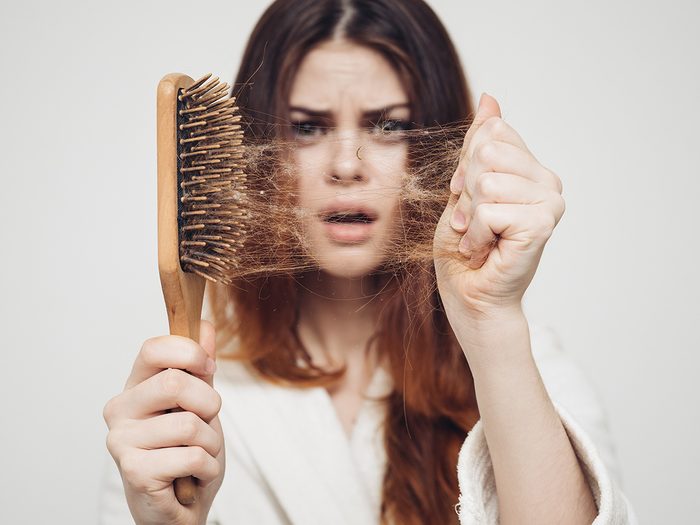Why is My Hair Falling Out?

There are many reasons you may notice your hair falling out—or sudden bald patches. Fortunately, most of them can be treated.
Hair loss is often begrudgingly accepted as a natural part of life. After all, most people, women included, will lose some or all of their hair as they get older. But when hair loss happens suddenly—handfuls of hair falling out in the shower or while brushing—it can be truly distressing. It can also be a signal of a health issue that needs to be addressed. (Here are 20 symptoms you should never ignore.)
Why is my hair falling out?
To understand why unexpected hair loss happens, it’s useful to know the growth cycle of healthy hair. Usually, most of your hair is in a growing phase, during which strands lengthen by about 1.25 centimetres a month. This part of the cycle carries on for between two and eight years.
After that, there’s a middle phase, lasting about three weeks, during which the hair isn’t getting longer but also isn’t falling out. Finally, strands enter a resting phase, where the hair is loosened but sits in its follicle. Then, when the follicle begins to grow a new hair, the old one drops out.
Due to this cyclical process, we all lose up to 100 strands of hair each day. “At any one time, about 10 per cent of our hair is in the falling out phase,” explains Jennifer Jones, a dermatologist who practices in London, England, and is an advisor to the British Association of Dermatologists.
When that balance is disrupted, a person can have too much hair in the resting phase—and a few months later, he or she might find a large amount of hair falling out all at once.
One of the main triggers for this disturbance is hormonal changes in the body. Estrogen keeps hair in the growth phase, while androgens shorten the growth cycle. For this reason, giving birth and thyroid issues—both of which shift the balance more toward androgens—can cause hair loss. “Stress is also a massive trigger,” says Jones. “So life events like divorce, bereavement or even moving house have this effect.”
Another common culprit is autoimmune conditions, most notably alopecia. This condition, which affects two per cent of people worldwide, runs in families and can be activated by a stressful event. In some cases, alopecia is subtle; other times, sufferers lose all their hair—including their body hair, eyebrows and eyelashes. Patches of alopecia tend to grow back, while full-body loss is usually permanent.
Scarring from other autoimmune conditions—including eczema, psoriasis and lichen planopilaris—can lead to patches of hair loss. Similarly, ringworm, a fungal infection, can affect the part of the head that it appears on.
Some people on prescription drugs also experience a disruption of their growth cycle. For instance, hair falling out is a known side effect of some blood pressure medications, statins and hormone replacement therapy, among others. “If you notice hair loss, discuss it with your doctor,” says Jones. “We can often switch medications.”
Treating sudden hair loss
Treatment depends on the underlying cause. To discover that, a doctor might order blood tests, perform a small skin biopsy or examine the hairs under a microscope. If the loss is hormone- or stress-related, it is usually temporary, and resolves within a few months without any intervention.
For cosmetic solutions, topical steroids can help thicken hair, and hair transplants are another option. Some people, of course, simply embrace their baldness.
Next, check out 11 natural remedies for hair loss that are worth trying.






